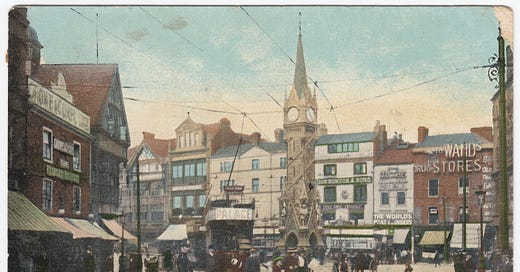"The evidence is very poor"
Why one Leicestershire detective found his skills being criticised by a judge
When Eileen Mary Collyer Stoney, a young woman from Ireland, married the dashing Corbett Cradock, she must have thought the couple had a glittering future ahead of them. Corbett was a horse dealer, land agent and surveyor, son of a Leicestershire father and Canadian mother; by the late 19th century, the family was based in Shinrone, County Offaly. She was the daughter of former Deputy-Surgeon-General Andrew Acres Stoney, of Frankford (Kilcormac), County Offaly, a man who had served in India during the mutiny. The couple married in April 1907 at Ballingarry Church, with Eileen, 23, wearing a simple ivory satin gown.
The couple had their son, Thomas Corbett, in Dublin in 1909, but then settled in Melton Mowbray, Leicestershire - Corbett had been living in the county since at least 1901. World War One saw Corbett serve with the Leinster Regiment, and although he suffered a head injury in 1917, he was not seriously hurt, and soon discharged from a hospital in London.
After the end of the war, the now Major Corbett Cradock settled with his family back into life in Leicestershire, but the marriage does not appear to have been happy, and by the 1920s, the couple were living in separate houses - Corbett at Salisbury Road in Leicester, and Eileen at Spinney Drive in Quorn.
Edwardian Leicester: the Corbetts lived in the city and in other parts of the county; private detective Henry Key was based at Upper Kent Street in the city in the 1920s.
Then things suddenly took an unexpected turn. Corbett's brother, Frank, left for America, leaving his wife Etta, and their children, behind. Eileen seems to have been rather jealous of her husband's friendship with his sister-in-law, especially when Frank's wife and children moved into Corbett's house, and decided to employ a local private detective, George Henry Key, to watch the building.
Key watched the house for a full month, and saw little. In fact, he only had one thing to report to his client: he had once seen a man's figure in the front bedroom, and thought it was Major Cradock - but he wasn't sure, and couldn't even say how Corbett was dressed. There was no sign of anything untoward, and the crux of the case seemed to be simply that Corbett had taken his family members in when his brother left, perhaps out of the goodness of his heart.
However, Eileen decided that George Key's evidence of the man in the bedroom was sufficient to prove that her husband was sleeping with Etta Cradock. She duly petitioned for a divorce on the grounds of her husband's adultery. This did not work out well.
In October 1928, at the Divorce Court, the private detective as well as Etta Cradock gave evidence in the case - and the jury duly stopped proceedings. They stated that they did not believe that Corbett Cradock had committed adultery at all. The judge agreed, dismissing the divorce petition, and commenting,
"The evidence for petitioner [Eileen] is very poor, and it is outrageous that on such evidence the case should have been brought. The petition ought never to have been launched."
George Key would not be the only private detective desperate to find evidence to please his client, but it was not a recipe for success. His 'evidence' was ridiculed by the divorce judge, and did not lead to the result that Eileen wanted. She had to remain married, and George Key would not become a well-known local detective after this case; he figures in no further press adverts or cases after this single one.
More is known of the wealthy Cradocks. Corbett escaped jail in 1930 when he hit the mother-in-law of the Leicester rugby club captain with his car. He was charged with manslaughter, but said he was not driving fast, was driving an unfamiliar car, and did not see the woman until immediately before he hit her. He was tried at the Leicester Assizes, but found not guilty. He remained married to Eileen, but their marriage was over in all but name. Within months of Eileen's death in 1940, Corbett remarried, but this marriage, although it might have been happier, was a lot shorter. He died six years later, in 1946.




